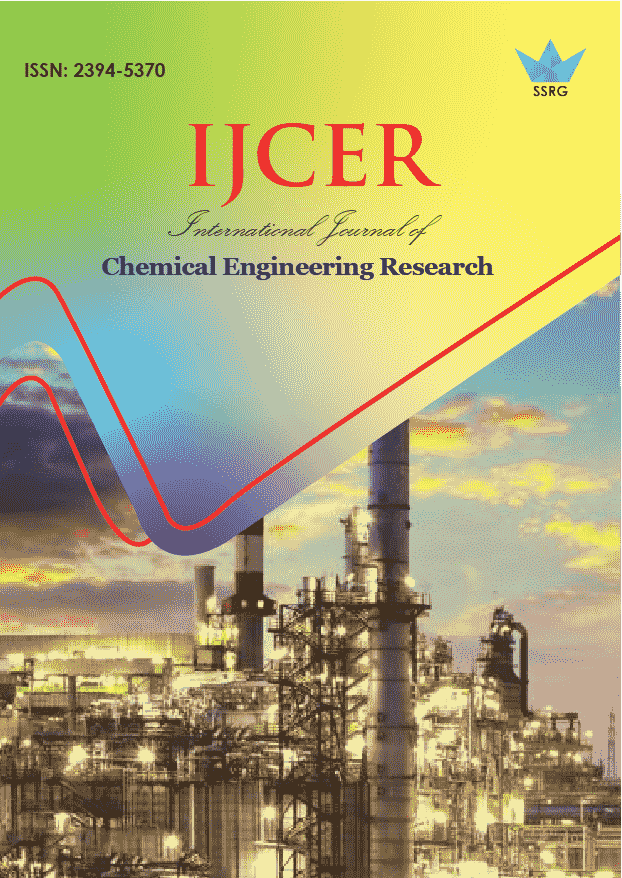Modeling,simulation and optimization Of Dehydrogenation and Dehydrocyclization Reactions

| International Journal of Chemical Engineering Research |
| © 2015 by SSRG - IJCER Journal |
| Volume 2 Issue 3 |
| Year of Publication : 2015 |
| Authors : Abdelrhman A.Yacoub, Rania Farouq, Hassan A.Farag, Shaaban Nosier |
How to Cite?
Abdelrhman A.Yacoub, Rania Farouq, Hassan A.Farag, Shaaban Nosier, "Modeling,simulation and optimization Of Dehydrogenation and Dehydrocyclization Reactions," SSRG International Journal of Chemical Engineering Research, vol. 2, no. 3, pp. 5-11, 2015. Crossref, https://doi.org/10.14445/23945370/IJCER-V2I2P102
Abstract:
Catalytic reforming of heavy naphtha is an essential process in oil industries. A mathematical model isconstrcteded to describe the reactions inside the reactorsand to be applicaple for an industrial catalytic reformer unit.The industrial reformer reactor is considered as an ideal plug flow reactor. The reaction network consisted of naphthenedehydrogenation and paraffin dehydrocyclization reactions which are the main reactions that take place in the reforming process.Themodel describe conservation equations of mass and energyused to determine the outlet concentrations of paraffins, naphthenes and aromatics for the main reactions in the reformer. This model includes four sequencing moving beds of catalyst at the steadystate condition which is based on components aggregation into one group (C7). This model is used to estimate the outlet temperatures from the first and the second reactor by using the computer program Matlab. The estimated outlet concentrations and temperatures agrees very well withtheindustrial data which were shown by small percent deviation. Based on the model of the whole reforming process and process variable analysis;sensitivity analysis is conducted. the process is optimized. Therefore, the model can be used in monitoring the performance of similar reactors.
Keywords:
Catalytic Reforming, Modeling, imulation,dehydrogenation ,dehydrocyclization
References:
[1] Maria S. Gyngazova, Anatoliy V. Kravtsov, Emilia D. Ivanchina, Mikhail V. Korolenko, NikitaV. Chekantsev, “Reactor modeling and simulation of moving-bed catalytic reforming process”,Chemical Engineering Journal,, 2011176– 177.
[2] Mohammad Reza Rahimpour, MitraJafari, DavoodIranshahi, “Progress in catalytic naphtha reforming process: A review”, Applied Energy , 2013,Vol. 109.
[3] James H. Gary and Glenn E. Handwerk; “PetroleumRefining Technology and Economics”, fourth edition, New York , Marcel Dekker, Inc.,2001.
[4] George J. Antos and Abdullah M. Aitani: “Catalytic Naphtha Reforming” second edition, revised and expanded, New York, Marcel Dekker, Inc., 2004.
[5] AboalfazlAskari, HajirKarimi, M.RezaRahimi, Mehdi Ghanbari, “Simulation and Modeling of Catalytic Reforming Process”, Petroleum &Coal , 2012,Vol. 54.
[6] M.R.Rahimpour, DavoodIranshahi, A.M.Bahmanpour, “Dynamic optimization of multi-stage sperical, radial flow reactor for the naphtha reforminf process in the presence of catalyst deactivation using deferential evaluation (DE) method” School of chemical engineering, Shiraz University, Iran.
[7] D.Iranshahi, E.Paurazadi, K.Paymooni, A.M.Banmanpour, A.Shariati, “Modeling of axial flow, spherical packed-bed reactor for naphtha reforming process in the presence of the catalyst deactivation”, school of chemical engineering, Shiraz University, Iran.
[8] F.Ali, F.Shohareh, M.Mohammad, G.Azadeh, “Mathematical modeling of industrial naphtha reformer with three adiabatic reactors in series”, School of chemical engineering, University of Tehran, I.R.Iran.
[9] H.M.Arani, S.Shokri, M .Shirvani, ”Dynamic modeling and simulation of catalytic naphtha reforming”, international journal of chemical engineering,2010, vol.1 no.2.
[10] L.ke-mein, G.Hai-yan, P.Shi-wei, “A study on naphtha catalytic reforming reactor simulation and analysis”, Shenyang University of technology, Liaoyang 111003, China.
[11] Zaidoon M.Shakoor, “Catalytic reforming of heavy naphtha analysis and simulation”, Chemical engineering dept., University of technology, Baghdad.
[12] Miguel A. Rodriguez, Jorge Ancheyte, “Detailed description of kinetic and reactor modeling for naphtha catalytic reforming”, Fuel journal, 2011, vol.90 Issue 12.
[13] Yongyou Hu, Hongye Su, Jian Chu, “Modeling, simulation and optimization of commercial naphtha catalytic reforming process”, national laboratory of industrial control technology, Institute of advanced process control, Zhejiang University, Yuquan Campus, Hangzhou 310027, P.R.China.
[14] Zuze Mu, Jinfu Wang, Tiefeng Wang, Yong Jin, “Optimum design of radial flow moving-bed reactors based on a mathematical hydrodynamic model”, Chem. Eng. Dept., Tsinghua University, Beijing 100084, P.R.China.
[15] M.Sa’idi, N.Mostoufi, R.Sotudeh-Gharebagh, “Modeling and simulation of continuous catalytic regeneration (CCR) process”, School of chemical engineering, University of Tehran, Iran.
[16] Khalid A.Sukkar, ShahrazadR.Raouf, RamzyS.Hamied, “Investigation and simulation of catalytic reforming reactions of Iraq heavy naphtha using Pt-Sn/Al2O3 and Pt-Ir/ Al2O3 catalysts”, Petroleum technology dept., University of Technology, Iraq.
[17] Anthony Poparad, Beatrix Ellis, Bryan Glover, Stephen Metro, "Reforming solutions for improved profits in an up-down world", UOP LLC, a Honeywell Company Des Plaines, Illinois, USA.
[18] Serge Raseev; "Thermal and Catalytic Processes in Petroleum Refining", New York, Marcel Dekker Publisher, 2003.
[19] H. M. Arani, M. Shirvani, K. Safdarian and E. Dorostkar, "lumping procedure for a kinetic modelof catalytic naphtha reforming", Brazilian Journalof ChemicalEngineering,2009, Vol.26.

 10.14445/23945370/IJCER-V2I2P102
10.14445/23945370/IJCER-V2I2P102